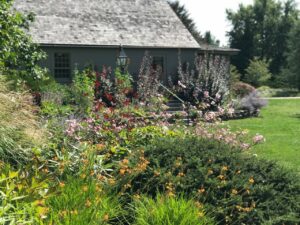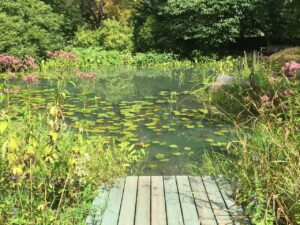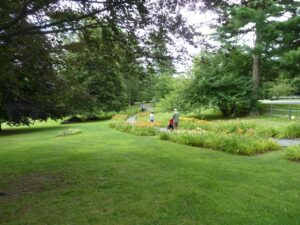By Colin McCandless, Contributing Writer

Photo/submitted
STOCKBRIDGE – When the weather warms and you’re eager for an outdoor excursion, it’s prime time to trek west into the Berkshires and experience the aesthetic beauty of Berkshire Botanical Garden in Stockbridge.
This nonprofit, membership-supported educational organization, encompassing 24 acres, highlights plants native to the Northeast region, according to Felix Carroll, Berkshire Botanical Garden’s director of marketing and communications. A variety of different display gardens are exhibited throughout the grounds. They feature lilies, primroses, an herb garden, vegetable gardens, a pond garden and a children’s discovery garden that is used for a kids’ camp. Art galleries are located on site within the grounds as well in this area full of big cultural attractions. Stockbridge is also home to the Norman Rockwell Museum, and Tanglewood — the summer home and training academy of the Boston Symphony Orchestra — is in nearby Lenox.
Origin in local garden clubs

Photo/submitted
Berkshire Botanical Garden was founded in 1934 by a group of local garden clubs and civic associations, some members of which donated the land and the original plant collection, said Carroll. The botanical garden was seeded with native plants while invasives were removed. The approach is to plant for pollinators and supply habitat for insects such as bumblebees and butterflies. “Everything is built to provide that habitat and food source,” stated Carroll.
Berkshire Botanical Garden shares its gardening philosophy and call to action with visitors, encouraging others to incorporate the same practices in their home gardens and focus on planting native species that attract pollinators. Carroll described the organization as the “brain trust of gardening in the region.”
What to see when you visit
Its display gardens and art galleries are open daily to visitors through Oct. 31 and timed, ticketed admission is required for all guests. Admission includes access to the gardens and art galleries and a self-guided audio tour. A guided group tour (free with admission) is offered daily at 11 a.m. from June 1-Sept. 1. “Everything is labelled,” noted Carroll of the display gardens, “But if you take the tour, you can see it through the eyes of a horticulturalist.”
Another visual gem is Lucy’s Garden, which features a collection of custom-designed topiaries including an elephant and other expertly sculpted creatures that were donated by a couple in Greenwich, Conn., and are stewarded by local topiarist Matt Larkin of Black Barn Farm in Richmond. It is considered one of the finest topiary collections in North America. “This is a really cool place,” asserted Carroll.
Trails meander through the gardens, and there are benches, picnic areas and a café serving lunch. The garden holds concerts in the summer on Monday nights.
Educational opportunities

Photo/submitted
To help fulfill its mission as an educational and environmental organization, Berkshire Botanical Garden provides ample learning opportunities. These include an array of online and in-person classes, lectures, workshops, exhibits and special events that inform people on the art and science of gardening and the preservation of our environment. Classes offered this year entail wide-ranging topics such as designing your backyard garden, soil science, chainsaw lessons, a spring wildflower primer, photography, cooking, art and more, said Carroll. “Educators can guide you on what is best to plant in your backyard.” Or conversely, what not to plant. “There’s a lot of talk about getting rid of invasive species which have taken over the landscape,” he added. They even have a master gardener hotline listed on their website that can answer specific gardening questions.
In addition to hosting field trip groups onsite, the garden’s educators visit students in area schools. “Berkshire Botanical Garden has programs within the schools to help teach them about how to build a garden on school property and cultivate it,” remarked Carroll. The nonprofit also launched a new project this season called “Garden in your Arms” that is specifically tailored to guide people on how to develop pollinator plants on their property. “We’re joining a national movement to rethink the American lawn,” explained Carroll. He elaborated that the lawn as it currently exists is often high maintenance and has been referred to as “an ecological desert.”
“So maybe reconsider replacing it with pollinator gardens and native species, he said. “We see the effects of what’s planted here and the biodiversity that develops because of it.”
Visitors typically spend approximately two hours exploring the gardens and the grounds. For more information, visit berkshirebotanical.org.
RELATED CONTENT:
Fabulous Fourth of July celebrations in Massachusetts (fiftyplusadvocate.com)
Stepping into the past at the homes of two famous writers (fiftyplusadvocate.com)
The fairy tale continues with Boston’s famed swan boats (fiftyplusadvocate.com)












